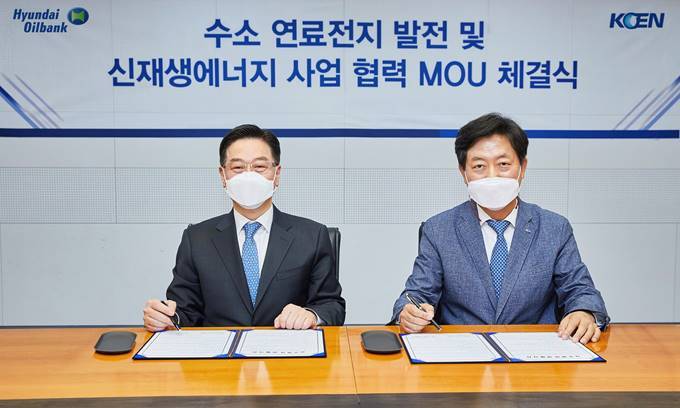Hyundai Oilbank to establish 100,000-ton blue hydrogen ecosystem
 |
|
Song Myung-joon (left), senior executive vice president at Hyundai Oilbank, and Bae Young-jin, executive vice president at Korea South-East Power, sign an agreement to co-develop renewable energy business on May 10. (Hyundai Oilbank)
|
Hyundai Oilbank said Monday it will establish a blue hydrogen ecosystem with an annual production capacity of 100,000 metric tons by 2025 and convert carbon generated from the production process into commercial products such as dry ice.
According to the South Korean energy company, the ecosystem will extract hydrogen from natural gas and refinery by-products and remove carbon to make the hydrogen “blue.” The hydrogen will be then transported, delivered and supplied to customers to generate electricity while the removed carbon will be turned into products such as building materials and fertilizers.
Although hydrogen itself has no color, it is described with the color description to differentiate its source. Blue hydrogen is produced from natural gas with carbon capture technology, while ”green“ hydrogen, the cleanest one, is made from water using renewable energy and does not emit carbon.
To set up the ecosystem, Hyundai Oilbank last month teamed up with Air Products, the world’s largest hydrogen producer, which is based in Pennsylvania. Air Products has source technologies that can extract hydrogen from various raw materials and also expertise on plant operation and storage, transportation and liquefaction of hydrogen.
Hyundai Oilbank aims to utilize Air Products’ technologies for its blue hydrogen ecosystem and further expand the partnership to green hydrogen business. Since July, Air Products has been running a project in Saudi Arabia that creates ammonia using electricity generated by solar and wind power. Ammonia can be later divided into nitrogen and hydrogen without emitting carbon.
On top of producing hydrogen, Hyundai Oilbank aims to generate electricity with it. This month, the company came together with Korea South-East Power to form a joint venture and generate electricity with hydrogen fuel cells. Starting next year, major electricity providers, including KOEN, will be obligated to produce a certain percentage of electricity with hydrogen.
Korea aims to increase the generation capacity of hydrogen fuel cells from the current 650 megawatts to 8,000 megawatts and the scale of the domestic market is expected to reach 7 trillion won ($6.2 billion).
“In 2006, KOEN became the first power company in Korea to produce electricity with hydrogen fuel cells. With Hyundai Oilbank’s hydrogen manufacturing capacity and KOEN’s green technologies, the partnership will create synergies that can boost both efficiency and competitiveness,” a Hyundai Oilbank official said.
By Kim Byung-wook (kbw@heraldcorp.com) (THE KOREA HERALD)
